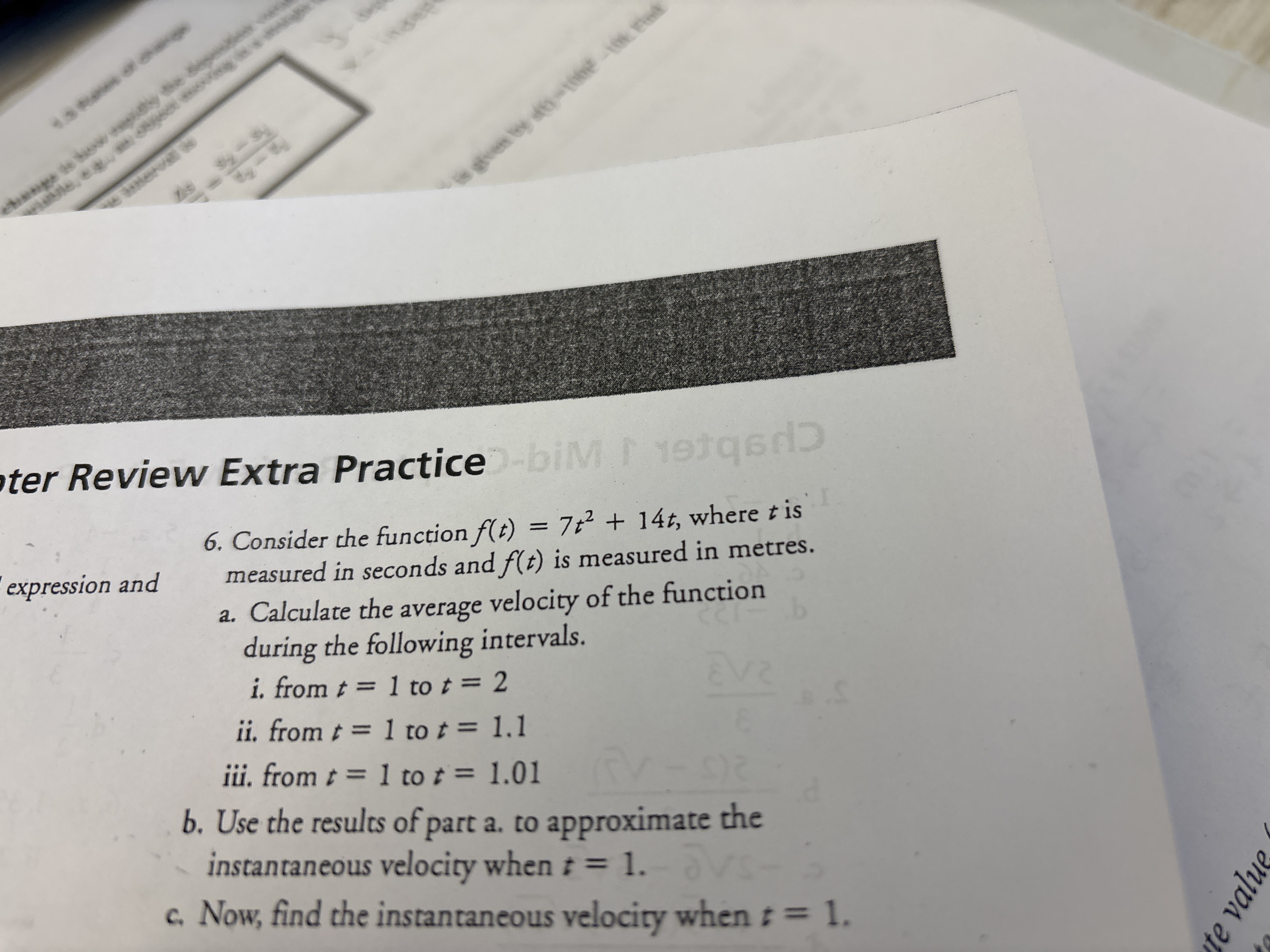Consider the function f(t) = 7t^2 + 14t, measured in seconds. a. Calculate the average velocity of the function during the following intervals: i. from t = 1 to t = 2 ii. from t =... Consider the function f(t) = 7t^2 + 14t, measured in seconds. a. Calculate the average velocity of the function during the following intervals: i. from t = 1 to t = 2 ii. from t = 1 to t = 1.01 iii. from t = 1 to t = 1.1 b. Use the results of part a to approximate the instantaneous velocity when t = 1.

Understand the Problem
The question is asking to calculate the average velocity of the function f(t) = 7t^2 + 14t over specified intervals and also to find the instantaneous velocity at a specific point. This involves evaluating the function over given intervals and applying calculus concepts.
Answer
The instantaneous velocity at $t = 1$ is approximately 28.5.
Answer for screen readers
The average velocities calculated over the specified intervals are:
- (i) 35
- (ii) approximately 28.07
- (iii) approximately 28.7
The instantaneous velocity at $t = 1$ is approximately 28.5.
Steps to Solve
- Calculate the function values at the endpoints To find the average velocity over an interval, we need to evaluate the function at the endpoints.
-
For interval (i), from $t = 1$ to $t = 2$:
- $f(1) = 7(1^2) + 14(1) = 7 + 14 = 21$
- $f(2) = 7(2^2) + 14(2) = 7(4) + 28 = 28 + 28 = 56$
-
For interval (ii), from $t = 1$ to $t = 1.01$:
- $f(1) = 21$ (from above)
- $f(1.01) = 7(1.01^2) + 14(1.01) = 7(1.0201) + 14.14 \approx 7.1407 + 14.14 \approx 21.2807$
-
For interval (iii), from $t = 1$ to $t = 1.1$:
- $f(1) = 21$ (from above)
- $f(1.1) = 7(1.1^2) + 14(1.1) = 7(1.21) + 15.4 = 8.47 + 15.4 \approx 23.87$
- Calculate the average velocities for each interval The average velocity is calculated using the formula: $$\text{Average velocity} = \frac{f(b) - f(a)}{b - a}$$
-
For interval (i): $$\text{Average velocity} = \frac{56 - 21}{2 - 1} = \frac{35}{1} = 35$$
-
For interval (ii): $$\text{Average velocity} = \frac{21.2807 - 21}{1.01 - 1} = \frac{0.2807}{0.01} \approx 28.07$$
-
For interval (iii): $$\text{Average velocity} = \frac{23.87 - 21}{1.1 - 1} = \frac{2.87}{0.1} \approx 28.7$$
- Approximate the instantaneous velocity at $t = 1$ The instantaneous velocity can be estimated by taking the limit of the average velocity as the interval approaches zero. We will use the results from (ii) and (iii):
Using the average velocities from (ii) and (iii): $$\text{Instantaneous velocity} \approx \text{average velocity as interval shrinks} \approx 28.07 \text{ or } 28.7$$
By extending this approximation further, we could assume the instantaneous velocity approaches around 28.5.
The average velocities calculated over the specified intervals are:
- (i) 35
- (ii) approximately 28.07
- (iii) approximately 28.7
The instantaneous velocity at $t = 1$ is approximately 28.5.
More Information
The function $f(t) = 7t^2 + 14t$ showcases a parabolic motion where the velocity varies over time. The calculation of average velocity over intervals helps to approximate the instantaneous velocity at a certain point using limits.
Tips
- Forgetting to properly evaluate the function at the endpoints, leading to incorrect average velocity calculations.
- Not using the correct formula for average velocity or misinterpreting the interval measurements.
AI-generated content may contain errors. Please verify critical information